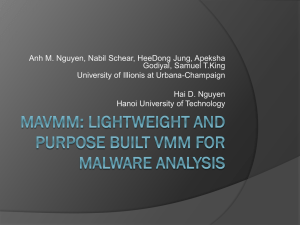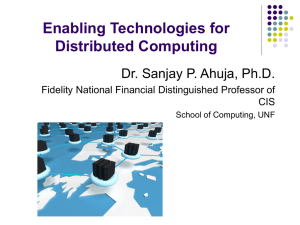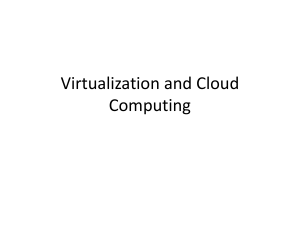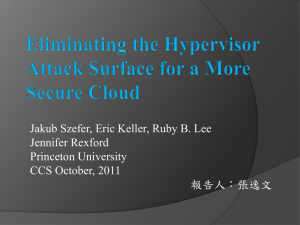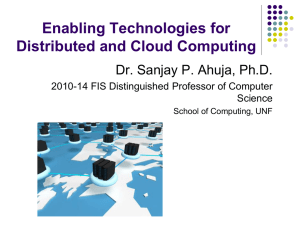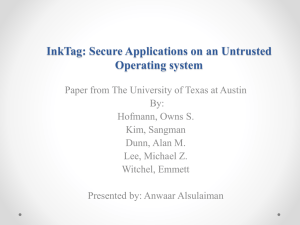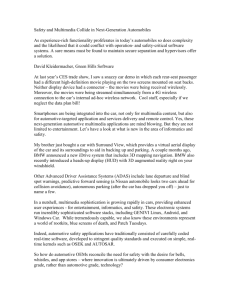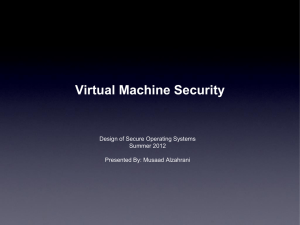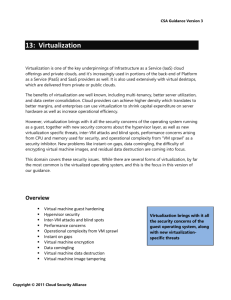Virtualization Types of Interfaces
advertisement
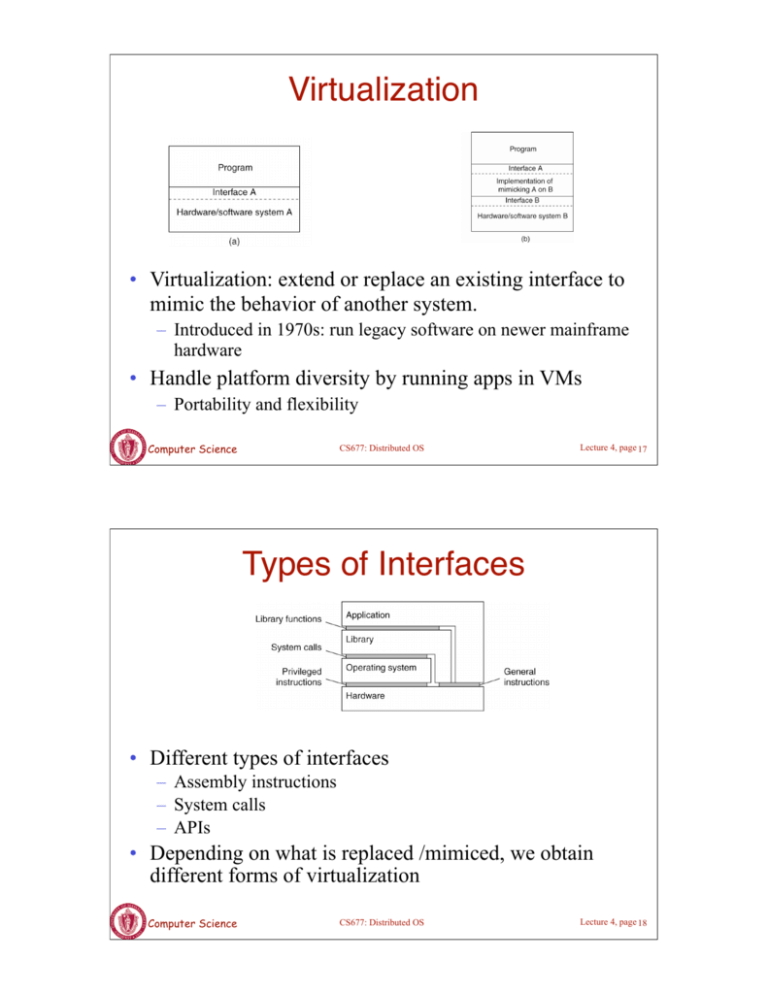
Virtualization • Virtualization: extend or replace an existing interface to mimic the behavior of another system. – Introduced in 1970s: run legacy software on newer mainframe hardware • Handle platform diversity by running apps in VMs – Portability and flexibility Computer Science CS677: Distributed OS Lecture 4, page 17 Types of Interfaces • Different types of interfaces – Assembly instructions – System calls – APIs • Depending on what is replaced /mimiced, we obtain different forms of virtualization Computer Science CS677: Distributed OS Lecture 4, page 18 Types of Virtualization • Emulation – VM emulates/simulates complete hardware – Unmodified guest OS for a different PC can be run • Bochs, VirtualPC for Mac, QEMU • Full/native Virtualization – VM simulates “enough” hardware to allow an unmodified guest OS to be run in isolation • Same hardware CPU – IBM VM family, VMWare Workstation, Parallels,… Computer Science CS677: Distributed OS Lecture 4, page 19 Types of virtualization • Para-virtualization – – – – VM does not simulate hardware Use special API that a modified guest OS must use Hypercalls trapped by the Hypervisor and serviced Xen, VMWare ESX Server • OS-level virtualization – OS allows multiple secure virtual servers to be run – Guest OS is the same as the host OS, but appears isolated • apps see an isolated OS – Solaris Containers, BSD Jails, Linux Vserver • Application level virtualization – Application is gives its own copy of components that are not shared • (E.g., own registry files, global objects) - VE prevents conflicts – JVM, Rosetta on Mac (also emulation), WINE Computer Science CS677: Distributed OS Lecture 4, page 20 Types of Hypervisors • Type 1: hypervisor runs on “bare metal” • Type 2: hypervisor runs on a host OS – Guest OS runs inside hypervisor • Both VM types act like real hardware Computer Science CS677: Distributed OS Lecture 4, page 21 How Virtualization works? • CPU supports kernel and user mode (ring0, ring3) – Set of instructions that can only be executed in kernel mode • I/O, change MMU settings etc -- sensitive instructions – Privileged instructions: cause a trap when executed in kernel mode • Result: type 1 virtualization feasible if sensitive instruction subset of privileged instructions • Intel 386: ignores sensitive instructions in user mode – Can not support type 1 virtualization • Recent Intel/AMD CPUs have hardware support – Intel VT, AMD SVM • Create containers where a VM and guest can run • Hypervisor uses hardware bitmap to specify which inst should trap • Sensitive inst in guest traps to hypervisor Computer Science CS677: Distributed OS Lecture 4, page 22 Type 1 hypervisor • Unmodified OS is running in user mode (or ring 1) – But it thinks it is running in kernel mode (virtual kernel mode) – privileged instructions trap; sensitive inst-> use VT to trap – Hypervisor is the “real kernel” • Upon trap, executes privileged operations • Or emulates what the hardware would do Computer Science CS677: Distributed OS Lecture 4, page 23 Type 2 Hypervisor • VMWare example – Upon loading program: scans code for basic blocks – If sensitive instructions, replace by Vmware procedure • Binary translation – Cache modified basic block in VMWare cache • Execute; load next basic block etc. • Type 2 hypervisors work without VT support – Sensitive instructions replaced by procedures that emulate them. Computer Science CS677: Distributed OS Lecture 4, page 24 Paravirtualization • Both type 1 and 2 hypervisors work on unmodified OS • Paravirtualization: modify OS kernel to replace all sensitive instructions with hypercalls – OS behaves like a user program making system calls – Hypervisor executes the privileged operation invoked by hypercall. Computer Science CS677: Distributed OS Lecture 4, page 25 Virtual machine Interface • Standardize the VM interface so kernel can run on bare hardware or any hypervisor Computer Science CS677: Distributed OS Lecture 4, page 26 Memory virtualization • OS manages page tables – Create new pagetable is sensitive -> traps to hypervisor • hypervisor manages multiple OS – – – – – Need a second shadow page table OS: VM virtual pages to VM’s physical pages Hypervisor maps to actual page in shadow page table Two level mapping Need to catch changes to page table (not privileged) • Change PT to read-only - page fault • Paravirtualized - use hypercalls to inform Computer Science CS677: Distributed OS Lecture 4, page 27 I/O Virtualization • Each guest OS thinks it “owns” the disk • Hypervisor creates “virtual disks” – Large empty files on the physical disk that appear as “disks” to the guest OS • Hypervisor converts block # to file offset for I/O – DMA need physical addresses • Hypervisor needs to translate Computer Science CS677: Distributed OS Lecture 4, page 28 Examples • Application-level virtualization: “process virtual machine” • VMM /hypervisor Computer Science CS677: Distributed OS Lecture 4, page 29 Virtual Appliances & Multi-Core • Virtual appliance: pre-configured VM with OS/ apps pre-installed – Just download and run (no need to install/comfigure) – Software distribution using appliances • Multi-core CPUs – Run multiple VMs on multi-core systems – Each VM assigned one or more vCPU – Mapping from vCPUs to physical CPUs Computer Science CS677: Distributed OS Lecture 4, page 30 Use of Virtualization Today • Data centers: – server consolidation: pack multiple virtual servers onto a smaller number of physical server • saves hardware costs, power and cooling costs • Cloud computing: rent virtual servers – cloud provider controls physical machines and mapping of virtual servers to physical hosts – User gets root access on virtual server • Desktop computing: – Multi-platform software development – Testing machines – Run apps from another platform Computer Science Lecture 4, page 31 Case Study: PlanetLab • Distributed cluster across universities – Used for experimental research by students and faculty in networking and distributed systems • Uses a virtualized architecture – Linux Vservers – Node manager per machine – Obtain a “slice” for an experiment: slice creation service Computer Science CS677: Distributed OS Lecture 5, page
